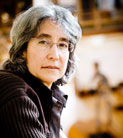Ingrid Birker: New ideas for old bones
Ingrid Birker: New ideas for old bones McGill University
User Tools (skip):
Profile
Ingrid Birker: New ideas for old bones
Ingrid Birker has the hushed voice of a museum curator. She has been responsible for invertebrate fossils and plants at the Redpath Museum for 24 years. But her new position requires her to use her voice somewhat more, and not only in the museum. She is the Science Outreach Coordinator, filling a one-year appointment created by Dean of Science Martin Grant, as part of a strategic plan for the faculty. "He knows we do a good job here; he wants to get us beyond the Roddick Gates," she says.

Birker has been singing with Montreal's only Balkan women's a cappella group, Dragana, since 1986. They cut their first CD in 2004, which made the top ten playlist of small community and campus radio stations in the States that summer, beating out 11th placer Ravi Shankar.
Claudio Calligaris
But just what is there for researchers and professors beyond the Roddick Gates? Something very important - future McGill students and young people who want to learn. Birker is preparing a list of talks on various subjects for professors to give to high school and CEGEP classes. Soon, Montreal teachers will be able to view this list on the McGill Faculty of Science website, choose a talk, and contact Birker about bringing a science faculty member to their classroom.
For example, if science teachers want their students to learn about engineering and robotics, they will be able to bring in one of McGill's robotics experts. Birker notes that there is already a group of graduate students who do some outreach called Let's Talk Science (www.letstalkscience.org), or LTS educators. Birker is excited about the possibility of working with this group to create a combination of expert speakers and hands-on activities. She says that many professors are enthusiastic about doing outreach; now her role is to coordinate McGill's science brains so that they can make an impact beyond McGill.
It makes sense that the Redpath Museum should be the hub for science outreach. It is the part of the McGill Faculty of Science that is most accessible to the public. "On weekdays, it's like this," she says, indicating the lone adult and two kids racing from display to display. "But on Sundays, we get lots of people." She has a stack of brochures describing all the programs available. The number of museum activities for both children and adults is overwhelming. There are Sunday workshops where kids can learn about the physiology of animal shells, dinosaur bones, or musical instruments. Then they make crafts like mounted shell collections, plaster fossil replicas or pipe-cleaner dinosaur skeletons. There are also science documentaries shown on Sundays, more formal lectures, and special events like origami workshops and Darwin Day.
McGill professors often put the Redpath Museum's unique resources to pedagogical use. Some classes use the Museum's samples of famous British Columbia Burgess Shale, stone imprinted with the shapes of arthropods like anomalocaris, a toothed and tentacled predator. Burgess Shale, immortalized in Stephen Jay Gould's book Wonderful Life, is an important example of the evolutionary concept of punctuated equilibrium - short periods of chaotic and rapid evolutionary change. McGill students are lucky that they can learn about these creatures in class and then come face to face with the actual fossils. Birker says that most exhibits correlate to courses or research being done on campus.
Birker may be best known for her Stones and Beer bike tour, a paleo-historical-architectural tour that ends at the McAuslan Brewery. A year-round biker, Birker shows off her knowledge of history, Montreal architecture, and ancient mollusks trapped in the limestone and bedrock of the city's buildings. The tour became so well publicized that Birker got a phone call from a Victoria, B.C., businessman who had read about the tour in the travel section of his local paper. He had a trip to Montreal coming up and wanted to know if he should bring his bike on the plane. Now that's outreach.

